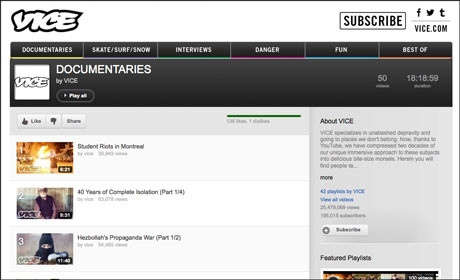
At the end of the 1990s Vice was a free fanzine distributed in Montreal, Canada; 15 years on and it is a global media company with offices in 34 countries.
While the magazine is still running and is "a really important part of what Vice is", it represents less than 5 per cent of the company's overall revenue. Last year the total revenue was more than $110 million and Vice is "on track in 2012 to generate significantly more", Dan'l Hewitt, general manager of AdVice, a division of Vice Media, told Journalism.co.uk.
As Vice moved online its focus evolved into online video, which has been driven by developments in technology. "The cost of video equipment and editing software came down, so we were able to create more video content for ourselves," Hewitt said.
"That started around five or six years ago and then with new platforms coming into the fold, places like YouTube and Vimeo and Facebook, we were able to syndicate and distribute our content to new audiences in those places."
Vice now has more than 30 ongoing video series franchises. They range editorially across fashion, music, travel, culture and art, and they are all character-driven, punchy stories created for a young audience. Or as described on the main Vice YouTube channel – which has notched up more than 25 million views – "Vice specialises in unabashed depravity and going to places we don't belong".The cost of video equipment and editing software came down, so we were able to create more video content for ourselves and get it out on our owned an operated propertiesDan'l Hewitt
The London office has recently put out documentaries such as an 'alternative guide to the Olympics' and a sports series called Rivals, with one film looking at the historic rivalry between the Rangers and Celtic football teams. The US Vice team gained attention for films which saw 24-year-old Hamilton Morris journey into the Amazon in a quest to hunt down rare hallucinogens.
"When we go out and film our documentaries, we do it very differently to other traditional media businesses," Hewitt said. "We won't go into places with big film crews, so our founder Shane [Smith] has been to North Korea, for example, and we tend to go in slightly guerilla in fashion."
The documentary on Rangers and Celtic involved 23-year-old journalist Kev Kharas and a cameraman/producer being embedded with fans for extended periods of time.
Documentaries can take months, Hewitt explained. "It allows us to produce content quite cheaply because the resources are low, but it also gives us an intimacy with the people that we are spending time with so there's trust built up as well."

Still from a film on rivalry between Rangers and Celtic fans
Making long-form video journalism pay
But although video can be produced "quite cheaply" in relation to the high cost of producing documentaries for TV and cinema, it still requires significant investment. So how does Vice generate sufficient revenue? Pre-roll ads and television-style advertising do not currently offer a solution, according to Hewitt.
"The commercial models around the creation of unique, original video content still don't work. If you think about our ability to be able to go to somewhere like Liberia and film a documentary on child genocide and warlords, if we were able to produce that at a cost of less than $50,000, which is incredibly cheap for a 40-minute, hard-hitting documentary, to realise any kind of return on that we would need to be able to deliver more than three million video streams based on current video ad models.The commercial models around the creation of unique, original video content still don't workDan'l Hewitt
"Three million video streams is a lot and not only that but you'd have to run ads on every single one of those videos streams, intrusive ads, big 30-second online TV ads effectively in front of this content. That doesn't work for us and we couldn't go down that route ourselves."
Vice has found its road to success lies elsewhere. "We work with brands to create legitimate content that talks to their consumers and their audience in the most appropriate way," Hewitt explained. "We don't think about branded content, we think about telling stories and making content that relates to brand messages or products."
Similarly, the Guardian is also focusing on brand partnerships for its long-form video productions. A link-up with Cobra beer saw Guardian Travel produce videos as part of a Mumbai city guide.
The Guardian sees huge potential for long-form video in "getting into people's living rooms" through advances in connected TV and distribution to iPad, Stephen Folwell, business director, multimedia and brand extensions, Guardian News & Media, told Journalism.co.uk.
And pushing Guardian documentaries onto TV can generate significantly more revenue than online, Folwell explained."We don't think about branded content, we think about telling stories and making content that relates to brand messages or productsDan'l Hewitt
So does Vice see a bright future in connected TV? "Our position on new distribution platforms is that we will go there when the audiences are there and the commercial models support what we are trying to do," Hewitt said.
"At the moment we are having great conversations with device manufacturers and they are all looking at ways to have unique original content that can differentiate their offering from their competitors. So we are part of those conversations. But for us it's really about where there is a viable commercial model around moving into those places."
While the Guardian is moving into the living room, Vice also sees audiences changing their behaviours and willing to watch long-form content whether via YouTube on a laptop or on mobile.
"We are seeing our engagement time and play-through of our longer-form content increasing week-on-week," Hewitt said. "The play-through, dwell-time and engagement is really significant for 40-minute documentaries."
Re-packaging and segmenting
Many publishers of online video journalism advocate that internet-native video should be short in length and follow different conventions than films made for TV. But now the boundaries are becoming blurred between online and television experiences, new rules are being written.
Vice is experimenting in finding the most appropriate way of "slicing up" longer-form documentaries into seven to 10-minute episodes, published in addition to the full-length documentary. They have done this with various fashion series and the 'alternative guide to the Olympics'.
Re-packaging is also something the Guardian does with its long-form videos. While it runs its film show as a 20-minute programme, it also packages up the individual films that are being reviewed which, according to Folwell, allows viewers to learn about a specific actor for film.
"In all the long-form we are doing now, probably with the exception of long-form investigations which we see as more stand alone pieces, we are thinking about how we can get them to work both as a single piece on TV or tablet but also more atomised versions on the desktop," Folwell said.
New horizons
In terms of distribution platforms Vice is focussing on both YouTube and its own player, Hewitt said. "YouTube is amazing because of scale and global reach it gives us and the pure democratisation of content in that space", the Vice-owned and operated video players allow the media company to keep 100 per cent of the revenue.
Vice is also investing and launching new technologies, including a Vice player, a syndicated video player to allow third-party publishers who do not produce their own video content but are "looking for ways to engage their audiences further and to benefit from the new revenue stream that comes from video monetisation".
Mobile video traffic "is significant and growing" with Vice responding by re-launching its mobile site, which is optimised for iPad and HTML5 streaming and "puts video front and centre of that experience".
And in addition to moving to looking to platforms in the online space, Vice is also being commissioned to create shows for television. There are two series running in Germany, it has produced a prime-time show with Viacom MTV in the US, and is currently in production on a "news and documentary-driven" commission for HBO.
- For more on Vice and the Guardian listen to Hewitt and Folwell speaking about opportunities in long-form video in Journalism.co.uk's latest podcast.
Free daily newsletter
If you like our news and feature articles, you can sign up to receive our free daily (Mon-Fri) email newsletter (mobile friendly).
Related articles
- Five key takeaways from the UK select committee on the future of news
- Standing out in a crowded market: what makes a top news podcast?
- Guardian launches a new section for readers in Europe
- Futureproofing your newsroom: understand your USP in a crowded space
- What does the future hold for newsletters?









